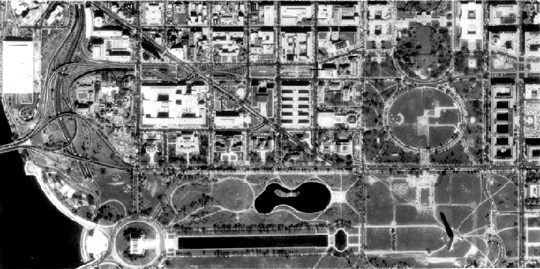Digital Orthophoto Quadrangles
Fact Sheet 057-01 (May 2001)

An image from part of a digital
orthophoto quadrangle of Washington, DC |
| |
A digital orthophoto quadrangle (DOQ) is a computer-generated
image of an aerial photograph in which image displacement caused
by terrain relief and camera tilts has been removed. It combines
the image characteristics of a photograph with the geometric
qualities of a map.
Characteristics of a USGS
Digital Orthophoto Quadrangle
DOQs produced by the U.S. Geological Survey (USGS) are either
gray-scale, natural color, or color-infrared (CIR) images with
1-meter ground resolution. They cover an area measuring
3.75-minutes longitude by 3.75-minutes latitude or 7.5-minutes
longitude by 7.5-minutes latitude. Each DOQ has between 50 and
300 meters of overedge image beyond the latitude and longitude
corner crosses embedded in the image. This overedge facilitates
tonal matching and mosaicking adjacent images.
The standard DOQ is formatted with an ASCII keyword header
followed by a series of 8-bit binary image lines. Color DOQs are
24-bit band-interleaved-by-pixel (BIP) images. The header
contains a wide range of data for identifying, displaying, and
georeferencing the image.
All DOQs are referenced to the North American Datum of 1983 (NAD
83) and cast on the Universal Transverse Mercator (UTM)
projection. Primary (NAD 83) and secondary (NAD 27) datum
coordinates for the upper left pixel are included in the header
so that users can spatially reference other digital data to the
DOQ.
The file size of a 3.75-minute gray-scale DOQ is 40-45
megabytes, and a 3.75-minute color or 7.5-minute gray-scale DOQ
can be three times this size.
|| Top ||
Main table of contents ||
Producing a Digital Orthophoto
Quadrangle
To produce a DOQ requires (1) a minimum of three ground
positions that can be identified on the photograph to be
rectified, (2) camera calibration parameters, such as the
calibrated focal length and the coordinates of the camera
fiducials, (3) a digital elevation model (DEM), and (4) a
digital image produced by scanning an aerial photograph with a
precise, high-resolution scanner.
The digital image is rectified to generate an orthophoto by
processing requirements 1 through 3 above for each image picture
element (pixel), using rigorous photogrammetric equations on a
computer. The finished product is a spatially accurate image
with planimetric features represented in their true geographic
positions.
|| Top ||
Main table of contents ||
Accuracy Requirements
The accuracy and quality of USGS DOQs must meet National Map
Accuracy Standards at 1:12,000 scale for 3.75-minute quarter
quadrangles and at 1:24,000 scale for 7.5-minute quadrangles.
Accuracy and quality depend on the following:
- photographs that meet National Aerial Photography
Program standards, which are quarter-quadrangle centered.
The photographs are exposed at a flying height of 20,000
feet above mean terrain;
- a DEM with the same area coverage as the DOQ and that is
equal to or better than a level 1 USGS DEM having a
root-mean-square error in elevation no greater than 7
meters;
- a highly accurate image-scanning process that uses a
scanning aperture between 7.5 and 32 micrometers (µm). A
1:40,000-scale image scanned with a 25µm aperture produces a
ground sample distance of approximately 1 meter; and
- identifiable ground control positions with coordinates
acquired from ground surveys or aerotriangulation.
|| Top ||
Main table of contents ||
Uses for Digital Orthophoto Quadrangles
A DOQ can be incorporated into any geographic information
system (GIS) that can manipulate raster images. It can function
as a cartographic base for displaying, generating, and modifying
associated digital planimetric data. Other applications include
vegetation and timber management, routing and habitat analysis,
environmental impact assess-ments, emergency evacuation
planning, flood analysis, soil erosion assessment, facility
management, and ground-water and watershed analysis. The
accuracy and extraordinary detail provided by the DOQ allow
users to evaluate their data for accuracy and completeness, make
real-time modifications to their data, and even generate new
files.
Distribution Media
DOQs are distributed in either native (standard) or GeoTIFF
format on a variety of media, including CD-R, DVD, and FTP as
uncompressed files.
|| Top ||
Main table of contents ||
Obtaining Digital Orthophoto
Quadrangles
Please contact one of our customer service reps at
800-248-6277 or
sales@GeoMart.com
|
